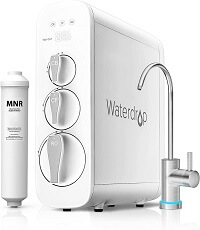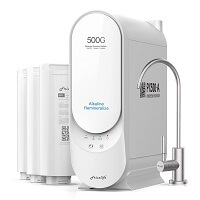There seemed to be water everywhere. You could walk by a nearby beach or witness sailboats on the small lake on your route to the office. During a lovely warm rain shower, you could experience it upon your skin. You could start washing a plate of fruit or vegetables within your kitchen by turning on the tap right now. We bathe in water, drink it and use it for cooking. Because of our ready water access, it appears to be practically inexhaustible. Even though water makes up 70 percent of the Earth's surface, just 1% of that water is pure and valuable. This 1% of freshwater is sourced from the ground, lakes, or rivers.
Your freshwater comes from either a public origin, such as water treatment services, or a private origin, such as wells. So, this water would be a byproduct of the water cycle of the Earth. Throughout this water cycle, water flows continuously through one reservoir toward the next. The water bodies are heated by the sun, causing them to evaporate. Water vapor condenses into clouds when it moves higher within the atmosphere due to the chilly temperatures. Cloud particles make bonds with one another, condensing vapor and forcing it to descend into water bodies like rainfall, sleet, or perhaps even snowfall. The cycle would then be restarted, with the sunlight warming the water bodies, thus triggering evaporation.
Source of Water
Groundwater
Groundwater provides about twenty percent of the globe's freshwater resources. Snow and rain are gathered below in an aquifer, which is a "rock pocket." A water table is the most significant depth at which the soil pore openings in Earth are filled with water. Groundwater may be accessible by digging a well in the Earth and rising towards the top in the manner of a spring. Most of it is utilized for irrigation and drinking. Whereas many states get their clean water via surface origins, aquifers like Memphis, San Antonio, and Miami get most of their freshwater from underground sources.
Surface Water
Surface water is the source of most of the drinkable water supply, primarily coming from snow and rain, which flows into streams, lakes, and rivers. Because it originates from the salty ocean, much surface water isn't perfectly drinkable unless treated. These sources of water are not usually close by. The West-of-Hudson Watershed spans. Watershed of the Catskill/Delaware that stretches 125 miles of the city's northwest. The water in Chicago comes from Lake Michigan and flows well over 100 miles. The Flint Rivers and Chattahoochee supply Atlanta's water, which flows a few 100 miles upstream. Individuals in 7 states across Denver towards Los Angeles depend on the Colorado River for drinkable water.
Water Transportation
Water must be treated before it reaches your taps for public safety and health purposes. Water treatment is the process of removing contaminants from water that render it hazardous to drink. This water might be drawn from either a surface origin or drawn from something like an aquifer. After being treated to satisfy the Clean Drinking Water Guidelines of the Environmental Protection Agency, U.S., drinkable water is delivered to storage sites wherein businesses and households may get clean, the safe drinking water right from their faucets. Water distribution networks in the United States cover almost one million miles & serve roughly three hundred million individuals. Hydrants, storage tanks, meters, pumps, control valves, Pipes and are all part of the distribution system, which is mainly underground.

Water Treatment Technology for Municipalities
An appointed official manages a municipal water treatment public facility that serves towns and cities. A personal water treatment plant might serve a single-family or perhaps a small number of families. There are numerous phases within the water purification process. Chemicals will be initially added, which collect dirt and various solids and eliminate them from the wastewater. Additional sediments settle to the bottle's base.
The water will then be filtered to eliminate tiny impurities like germs and grit. Lastly, the water gets disinfected using chlorine-based treatments. Next, the purified water travels via all of your city's underground pipes toward a water tower to create pressure before being delivered straight to your home.
To screen and sterilize dangerous bacteria, physical and chemical methods are implemented. Although water treatment technologies remove various pollutants, they don't permanently remove pollutants that create issues with the water, like the harsh taste, unpleasant odor, and mineral deposits.
Drinking Water Dangers
In so many areas of the globe, waterborne diseases like cholera giardia, typhoid, and hepatitis A are significant hazards for tourists and residents who consume water from the tap. The faucet water in the United States is generally safe; however, the country's treatment and distribution facilities aren't flawless. Approximately one-quarter of Americans acquire their drinkable water from suppliers that violate the EPA's Clean Water Standards.
The majority of them live in low-income remote rural regions. And although water is declared clean to drink whenever it exits a treatment facility, pipes within old distribution systems might pollute it. Outdated lead pipes & brass pipework manufactured before 2014 also leak lead into freshwater within businesses and homes. Screening water before drinking is the most effective technique to ensure safe, hygienic, and enjoyable.
Recommended RO System
Here are a few great choices for Reverse Osmosis systems:
The RO System For Filtering Tap Water By Waterdrop
This system will save up to 300% of water vs the standard filter systems with tanks. The Waterdrop RO system has little to no noise which means it's even quieter than your laptop! It's the perfect choice for those who own RVs due to its very compact design. This Waterdrop filter system also flushes itself in order to keep your water pure and clean 24/7. The RO filter system comes with a sleek metal faucet and will deliver a fast thorough water flow.
The Frizzlife RO Water Filter System
This system comes without a tank and fits perfectly under your sink. It will eliminate over 1,000 kinds of contaminants from water including chlorine and fluoride along with heavy metals, lead, limescale, and other harmful elements. Frizzlife takes up much less space while removing pollution caused by the unventilated tank. This system is very easy to install by simp0ly following the step-by-step video and detailed instructions in the user manual. Frizzlife produces far less wastewater as a RO system. Across the board, this system produces 1.5 cups of pure water with only 1 cup of wastewater being drained out.
The AMI RO Water Filtration System
You will enjoy great-tasting water from this compact water filtration system that fits perfectly under your sink. It will give you 5-stages of incredible water purification from the AMI Reverse Osmosis water purification filters that eliminate chemicals such as metals including copper, lead, chlorine, rust, and even bad odors. Don't just hope your water is clean and fresh, make sure it is by installing this system. AMI comes with very clear instructions and offers color-coded tubing to help you out.






